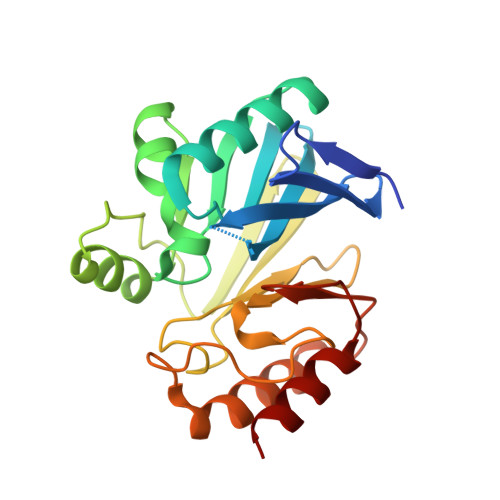Asp-120 locates Zn2 for optimal metallo-beta-lactamase activity.
Llarrull, L.I., Fabiane, S.M., Kowalski, J.M., Bennett, B., Sutton, B.J., Vila, A.J.(2007) J Biol Chem 282: 18276-18285
- PubMed: 17426028
- DOI: https://doi.org/10.1074/jbc.M700742200
- Primary Citation of Related Structures:
2UYX - PubMed Abstract:
Metallo-beta-lactamases are zinc-dependent hydrolases that inactivate beta-lactam antibiotics, rendering bacteria resistant to them. Asp-120 is fully conserved in all metallo-beta-lactamases and is central to catalysis. Several roles have been proposed for Asp-120, but so far there is no agreed consensus. We generated four site-specifically substituted variants of the enzyme BcII from Bacillus cereus as follows: D120N, D120E, D120Q, and D120S. Replacement of Asp-120 by other residues with very different metal ligating capabilities severely impairs the lactamase activity without abolishing metal binding to the mutated site. A kinetic study of these mutants indicates that Asp-120 is not the proton donor, nor does it play an essential role in nucleophilic activation. Spectroscopic and crystallographic analysis of D120S BcII, the least active mutant bearing the weakest metal ligand in the series, reveals that this enzyme is able to accommodate a dinuclear center and that perturbations in the active site are limited to the Zn2 site. It is proposed that the role of Asp-120 is to act as a strong Zn2 ligand, locating this ion optimally for substrate binding, stabilization of the development of a partial negative charge in the beta-lactam nitrogen, and protonation of this atom by a zinc-bound water molecule.
Organizational Affiliation:
Departamento de Química Biológica-Area Biofísica, Instituto de Biología Molecular y Celular de Rosario, Facultad de Ciencias Bioquímicas y Farmacéuticas, Universidad Nacional de Rosario, Suipacha 531, S2002LRK Rosario, Argentina.
















